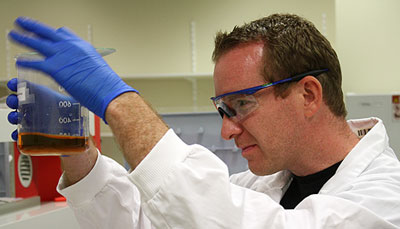| May 31, 2012 |
Under the influence of magnetic drugs
|
|
(Nanowerk News) For more than three decades scientists have been investigating magnetic nanoparticles as a method of drug delivery. Now by combining three metals - iron, gold and platinum - pharmacists at the University of Sydney believe they have discovered a method for magnetically directing drugs through the body.
|
|
The discovery has been published online today in the international journal Inorganica Chimica Acta.
|
|
Led by Dr Nial Wheate, a team of scientists from the Faculty of Pharmacy, along with collaborators in Scotland, have developed a new anticancer drug that has an iron oxide core as small as 5 nanometres in size.
|
 |
| Dr Nial Wheate: "This discovery means we can potentially direct where in the body a drug goes."
|
|
"We coated this iron oxide core in a protective layer of gold before cisplatin, a platinum drug that revolutionised the treatment of testicular cancer, was attached to the gold coating using spaghetti-like strings of polymer."
|
|
The important thing about this new drug, says Dr Wheate, is the ability of its iron core to move under the influence of a magnet; similar to the iron filing experiments many people have performed in science classes.
|
|
"When we take regular medication it is difficult to manage where it goes. But this discovery means we can potentially direct exactly where in the human body a drug goes. We can move it to the desired cancer tumour site using powerful magnetic fields. Otherwise, a strong magnet could be implanted into a tumour, and draw the drug into the cancer cells that way."
|
|
The technology was demonstrated when the team grew cancer cells in plates in the lab. When they placed a magnet under the plates, the drug affected and killed only those cells growing near the magnet, leaving the others unharmed, says Dr Wheate.
|
|
"Many of the side-effects associated with chemotherapy occur because the drugs spread throughout the body, killing healthy organs as well as cancers.
|
|
"Ultimately, this technology could greatly reduce or even eliminate the severe side-effects that people associate with chemotherapy such as hair loss, nausea, vomiting, low red blood cells and an increased risk of infection."
|
|
This new drug technology could also be used to treat a range of cancers that have not been treatable with conventional platinum drugs, like prostate cancer.
|
|
Platinum drugs are one of the most regularly used family of agents in chemotherapy and include cisplatin, carboplatin and oxaliplatin.
|

